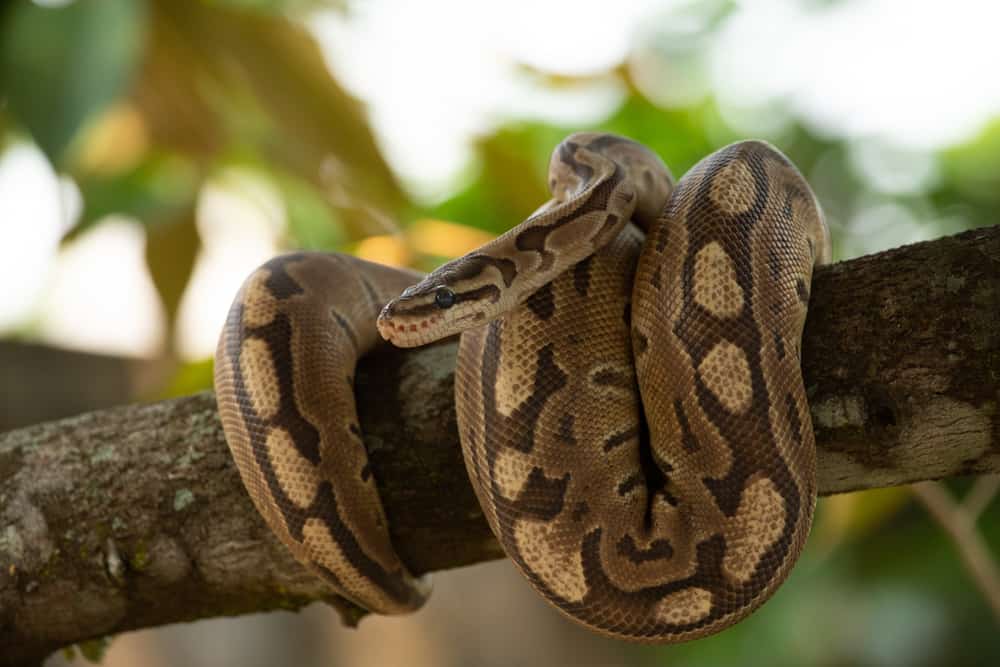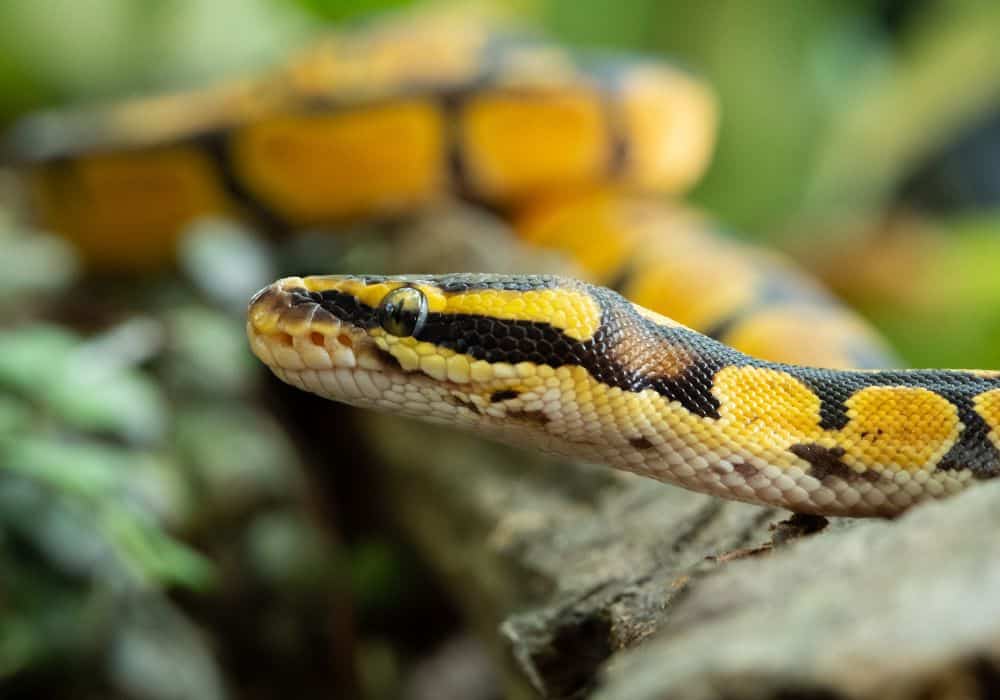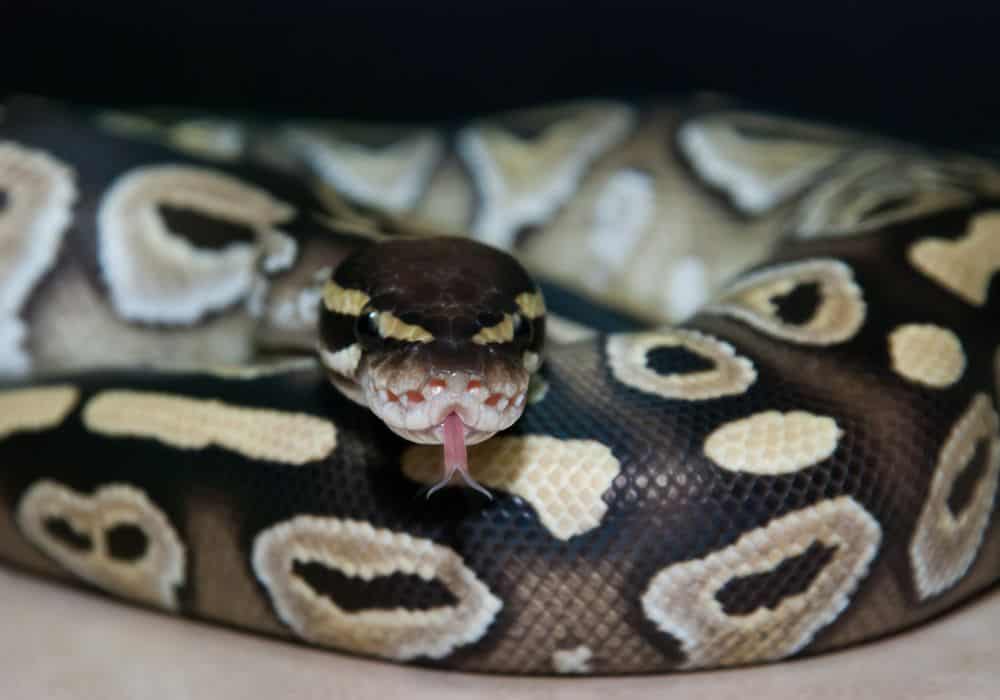The ball python is easily one of the most popular pet snakes on the market. They are docile, non-venomous, and simply beautiful.
And with a long life expectancy and a wide range of colors and patterns, owning a ball python is a worthwhile and rewarding experience.
Today we’ll explore why these snakes are so popular, from straightforward care tips and fun facts to working out what a ball python eats and how to create the perfect habitat for them.
Facts about ball pythons
Ball pythons are fascinating snakes. Here’s a quick rundown on some of the reasons why they’re a popular pet to own:
- The name refers to the snake’s tendency to curl into a ball when stressed or frightened.
- The ball python’s nickname is the ‘royal python’ because ancient royalty wore them as jewelry throughout history.
- Ball pythons can grow up to 182 cm or six feet long. They are some of the smallest pythons.
- Although they are not venomous, ball pythons have over 150 tiny teeth!
- Ball pythons can become very docile and recognize the scent of their owner
- On average, ball pythons live between 15-30 years in captivity. The oldest recorded ball python is over 62 years old and lives in Saint Louis Zoo.
- Male or female? The easiest way to tell your snake’s gender is by its appearance. Males are often smaller, with short, square, and blunt tails. Females are larger, with longer and pointier tails.
- There are a variety of ball python colors and patterns out there, called ‘morphs.’ These come in a wide range of colors and patterns and include everything from albino to bumblebee-yellow, lavender to banana, and more.
How and what do ball pythons eat?
Ball pythons are carnivores, meaning they are meat-eaters. They are non-venomous constrictor snakes, killing their prey by squeezing or constricting their movements.
By ambushing their prey, they wrap themselves around them and suffocate them. Each time the victim exhales, the snake tightens its grip, slowly limiting its breathing ability.
Afterward, the prey dies, and the snake consumes the prey whole.
In the wild, ball pythons hunt smaller prey than themselves, most often small rodents like mice and rats, birds, shrews, amphibians like frogs, and fish.
With a prolonged metabolism, ball pythons often take a long time to digest their prey and only hunt once every one or two weeks.
In captivity, ball pythons can eat a wide variety of prey, including mice and rats, hamsters, guinea pigs, rabbits, and gerbils, as well as small birds like chicks or quail chicks.
As primary meat-eaters, ball pythons should not be fed typical reptile snacks like large crickets or eggs. They take a long time to digest food, and these small meals lack proper nutrients and vitamins.
How to feed a Ball Python?
Snakes, especially ball pythons, can be fussy eaters and may not take to pre-killed food at first. There are some tips to try to entice your snake;
- Dangle the prey in front of your snake to mimic live movement.
- Place the prey facing away from the snake – they might be more comfortable if they think they are ambushing it.
- Coat it in chicken broth
- Consider a different food – some pythons prefer rat pups to pinky mice.
- Puncture the prey, so it bleeds
- The snake may not feel secure enough to feed. Move the tank to a quieter area and provide more shelter and hiding spots.
- Your snake might not eat if its enclosure is too cold
- It may have an internal parasite
Another common reason your snake may not have its appetite is that they’re about to shed. If scales look pale and their eyes are milky-colored, leave them for a few days and try again.
What kind of habitat suits a ball python?
Like any reptile pet, you should try to mimic their natural environments to ensure your snake will be happy and healthy. Ball pythons originate from West and Central Africa and live in grasslands, savannas, and open forests.
- Temperature
The most important thing to ensure is that your tank is warm enough for them. Aim for approximately 77 – 85 ° F using heat lamps, heat panels, or heat pads.
Place all heating equipment on the side of the tank to create a ‘basking spot,’ and leave an area where your snake can go to cool off.
Gently mist the tank with water each day to keep your snake appropriately moist. Avoid using heat rocks, as these can burn the ball python’s sensitive skin.
- Trees & branches
Ball pythons shed their skin once every 4-6 weeks, and the process lasts up to 2 weeks. To help them shed, you should place coarse materials throughout their tank that they can rub against, e.g., branches or stones.
- Hiding spots
Ball pythons tend to curl up when feeling threatened. If you witness nervous behavior, you should provide several hiding spots throughout the tank to help your snake feel safe and secure. These can be simple stones, rocks, or bark and mulch that the snake can burrow in.
Tips on feeding ball pythons
Snakes are natural-born predators; mimicking this trait will ensure your snake is happy, healthy, and mentally stimulated. But as with any pet, there are certain things you must consider.
Separate place for eating
You don’t want your ball python to associate the lid lifting with continuously being fed. Otherwise, they might be very aggressive when all you want to do is check in on them or hold them.
When feeding your snake, it’s often a good idea to only feed them in separate tanks or cages. The snake will associate this new place with when its feeding time.
Dead or alive?
You have a choice when it comes to food for your snake – either dead or alive. There are bonuses to both and some considerations to keep in mind.
Live prey has essential nutrients like protein and calcium that your snake needs. They contain all the organs (brain, lungs, etc.) and bones the snake needs for a well-balanced diet. The most common prey to buy at the pet store will be baby mice, often nicknamed pinkies. Pinkies are defenseless, usually only a few days old.
Older live prey can be more challenging to eat and bite your snake, especially if they are just hatchlings.
If in doubt, avoid live prey until your snake has become more assertive. Live prey will also have to be bought fresh and can be time-consuming to source.
Pre-killed food allows you to stockpile frozen meals and prepare them when needed. Depending on what you buy, they can contain all the nutrients of live prey.
Always ensure that you properly thaw food out beforehand. Leave in your fridge to defrost, and coat it with warm water before meal time. Don’t use a microwave – this can improperly heat your prey and burn your snake.
How often and how much?
Ball pythons are one of the few constrictor snakes to eat prey smaller than themselves. Please do not give them anything bigger than the most significant part of their body (usually their mid-section).
Ball pythons can be overfed, which leads to constipation. As such, you should only feed them when necessary.
As a rule of thumb, young snakes should feed every five or six days. Adult ball pythons older than one year should feed every 7 to 10 days. Older snakes will eat less frequently as their metabolism slows down.
Let them digest
As reptiles, snakes have a much slower metabolism than humans. You should leave your snake alone after feeds from 24 to 72 hours. Avoid picking them up and holding them. Interrupting their digestion can stress them out, leading to regurgitation and panic.
What are ball pythons’ predators?
As we know, ball pythons kept as pets have a great life expectancy. But wild ball pythons often don’t reach high ages because of predation. They are slow, especially after eating.
Common predators of ball python snakes include:
- Other snakes, like cobras.
- Birds, like eagles, hawks, and owls.
- Big cats, like lions.
- Canines, like hyenas, jackals, and wild dogs.
- Humans hunt the snakes for their skin and their meat.


